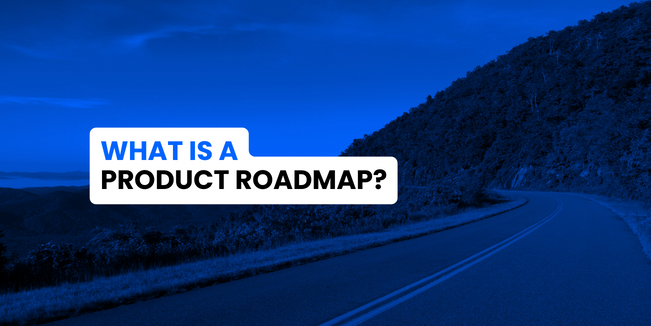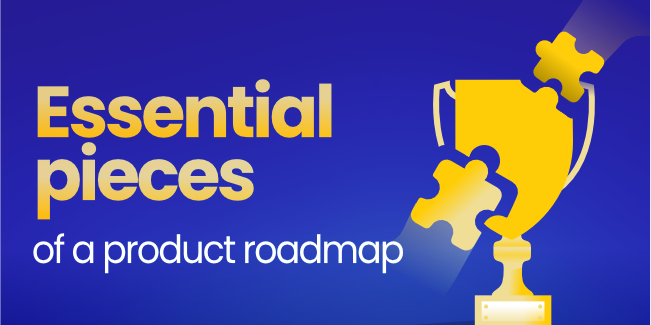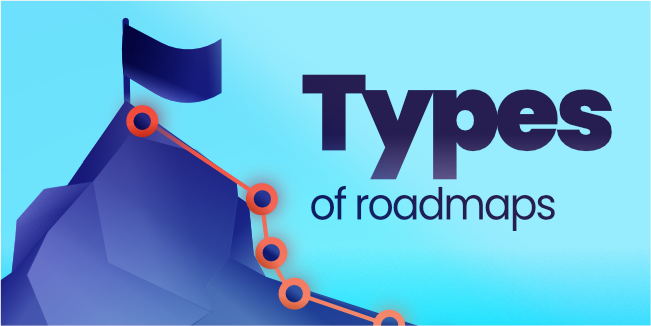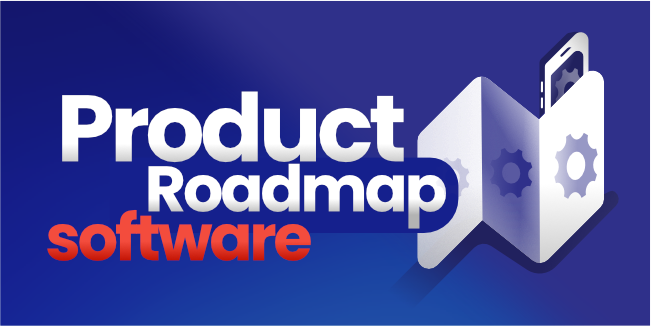development
productroadmap
What is a Product Roadmap?

A product roadmap is a graphical representation that depicts goals or desired outcomes and actions. Product roadmaps represent the results you want to achieve and how a product will develop over time. It's a vital coordination tool that allows everyone involved in the project to understand the company's overall product strategy.
A Product Roadmap is one of the stages of our Discovery Workshop. If you want to find out how we use the Product Roadmap in our work with partners and contractors, be sure to visit our article "Product Roadmap - how to write user stories and user flows?".
Cross-functional teams provide input to the product managers, who steer the roadmap. They also necessitate collaboration between all parties involved. A good product roadmap is always up to date – it isn't a one-time document that cannot be altered.
Every business has a different product strategy, so everyone must know it. Therefore, all organizations function in their way, engaging the personnel that your product plan will impact.
A product roadmap is a high-level visual summary of your product offering's vision and direction. A product roadmap informs about the why and what of what you're creating. A roadmap serves as a strategic guide and a plan for executing the product strategy.
The product vision includes several ultimate objectives:
- Describe the vision and strategy
- Provide a guiding document for executing the strategy
- Get internal stakeholders in alignment
- Facilitate discussion of options and scenario planning
- Help communicate with external stakeholders, including customers
A product roadmap is a plan that outlines how a product will evolve. It typically includes key milestones, deliverables, and features that will be added to the product. Roadmaps are essential for coordinating the product development process.
Why are product roadmaps important?
A product roadmap is crucial because it helps ensure that products are developed coordinated by a product manager. It also provides a framework for stakeholders to understand how the product will grow and change over time.
Internal and external stakeholders can use product roadmaps. Internal stakeholders include product managers, engineers, and designers. External stakeholders include customers and partners.
One of the benefits of using a product roadmap is that it can help get internal stakeholders in alignment. It is essential because different stakeholders may have different views on how a product should be developed. The product roadmap can help facilitate the discussion of options and scenario planning.
Another benefit of using a product roadmap is that it can help communicate with external stakeholders. External stakeholders often have a different perspective on products than internal stakeholders do. The product roadmap can help to explain how the product will change over time and what features will be added. It can help ensure that external stakeholders are kept up.
Essential pieces of a product roadmap

Key milestones: These are primary goals that need to be achieved for the product to be considered successful.
Products or services: This section defines what the product will look like at each milestone.
Dependencies: There may be some milestones that require other stakeholders to deliver on their end of a project before proceeding with yours. It is crucial to identify and communicate any potential blockers in these cases.
Releases: Releases show when the features in your product roadmap will be available for use or purchase. Product roadmaps are commonly organized into three phases: "current," "next," and "future." Product owners use roadmaps to outline future product functionality and when new features will be released.
Detailed launch plans: These are specific steps to be completed to launch the product.
Key assumptions & dependencies: Several factors associated with products may change over time, but these should be well documented to ensure that everyone is on the same page.
Managing tradeoffs: All projects entail making sacrifices for others to move forward. For example, development resources could be reallocated to finalize a particular feature, or a release timeline could be extended for a vital piece of functionality to be added. These details in the roadmap make it easier for stakeholders to understand why something has been prioritized over other features or tasks.
The Principles of Building a Product Roadmap
Product roadmaps are created early in the life cycle and are updated as the product develops. Teams can use them internally to help prioritize work, or they can be shared with stakeholders to get feedback and ensure everyone is on the same page.
A good product roadmap should:
- Be clear and concise.
- Include high-level goals as well as specific tasks.
- Show how tasks relate to one another.
- Balance the need for speed with the need for accuracy.
- Managing tradeoffs: All projects entail making certain sacrifices to move forward. For example, development resources could be reallocated to finalize a particular feature, or a release timeline could be extended for an essential piece of functionality to be added. Having these details included in the roadmap helps stakeholders understand if the product is still on track for hitting its goals.
- Clearly communicate vision and strategy: The product roadmap should tie directly into your business's mission, vision, and procedures outlined in other key documents. If you're building a new suite of tools, look at other vital documents like company value proposition or competitive differentiation to determine what success would look like for this new product. It will help keep everyone aligned throughout the development process since it ensures that everyone understands how individual tasks contribute towards the project's overarching goal.
- Keep stakeholders informed: Updates don't need to be daily but sending out regular updates (i.e., once per quarter) shows that you're thinking about where you want to go and how you're going to get there. It also allows stakeholders to provide feedback and help steer the project in the right direction.
- Encourage creativity: Giving team members the space to be creative is essential for generating new ideas and keeping motivation high. However, it's also necessary to have a process for vetting these ideas and determining which ones are worth pursuing. Establishing a straightforward procedure will help reduce confusion and ensure everyone is on the same page.
- Track progress: It's essential to track progress to determine whether you're on track or not. This information can then be used to make course corrections if necessary. Various tools are available for tracking progress, such as datasheets, burn-down charts, and Gantt charts.
- Identify a champion: One crucial role of a Product Owner is finding a champion for new ideas. The Product Owner's responsibility is to ensure that champions have sufficient time and resources allocated to them to spend part of their week driving new efforts. It's also the Product Owner's responsibility to remove obstacles from champions' paths by helping them access information, resolve conflicts with other groups, and ensure that they're not being pulled in too many directions. A champion who doesn't have enough time or attention isn't going to be very effective, but if you give them too much, it won't leave any time for anything else on their plate.
The different types of product roadmaps

Roadmapping is an excellent tool for capturing and communicating your product development plans. There are numerous product roadmaps, and each will be more or less helpful depending on certain variables. When multiple teams work together, the roadmap keeps them focused on priority or high-value outcomes. Let's look at some of the most frequent product roadmaps and how they may help you accomplish your objectives.
Portfolio roadmap
A portfolio roadmap presents the planned releases for several items in one picture. It helps provide a strategic overview of your strategy to executives or advisory boards. It may also aid team members (product development teams) in comprehending how their projects are connected to the efforts of other departments.
Strategy roadmap
A strategy roadmap illustrates the team's objectives and high-level efforts that it needs to invest in to achieve product goals. It's an excellent method of communicating your plans to executives while also providing staff at the same time a sense of how different releases fit into the business plan.
Agile Product Roadmap
An Agile product roadmap is a method for planning the development of an innovation. When Agile teams work on numerous aspects of a product simultaneously, priorities and strategies are changed.
Releases roadmap
The roadmap for a software release shows the tasks that must be completed before the software can reach the market — what needs to occur and who is accountable for delivering it. It helps align release activities with other cross-functional teams, such as sales and customer support.
Theme Roadmap
This roadmap is a sensible approach to convey the following enhancements that will be implemented to satisfy corporate goals or unmet consumer demands. This map shows where the product is heading and how it intends to get there.
Timeboxed Roadmap
A more detailed version of the release plan includes additional information about individual features or types of releases. Like the release timetable, this map is extensive but does not include dates. It's used as a reminder and communication for the team to ensure that work is completed on time for a specific date.
Capacity Roadmap
This one is like the release plan but with no dates; it's a communication tool for departments or components and displays what types of goods are anticipated to be developed. This map is mainly utilized to discuss resources required, not particular deliverables.
Market Requirements Roadmap
This plan allows a company to define its product and market positioning. This roadmap documents how the strategy and types of goods correspond to customer or user needs.
Opportunity Roadmap
This one is for companies that sell to businesses. It aids in aligning business development efforts with effective plans so that consumers may be acquired systematically. For example, It's frequently produced after much significant work has been completed on all primary features planned for release.
Project Roadmap
This roadmap brings teams and people working on different products or projects together. It allows individuals to see how their job fits in with the rest of the company's release plans.
How to plan a roadmap?

It's challenging to create a detailed roadmap—but with some focus and ruthless prioritization, you can usually handle the majority of issues and challenges that come with it. Narrow down the priorities you want to address for a set length of time, create priority-based goals that focus on outcomes and solutions rather than feature delivery dates and define the success criteria (metrics and KPIs).
The first step in road mapping is to identify and prioritize the critical elements of your business. You'll be on the right track if you commit to doing it correctly and sharing it with your teams.
Make a goal for a certain length of time
You should always look at the big picture. Ideally, you're laying out a strategy for the next few months or quarters. Product managers seldom know what will happen a year (market fluctuations, new user needs discovery), so focusing on a one-year time frame is pointless. It would be best to have the who, what, and how for the month and quarter devoted to attaining a high-level objective or two (for agile teams and startups, even that timeframe might be ambitious!).
How do you figure out what product objectives for a quarter are required? It all begins with the product vision - the purpose of developing the product. Everything you do should be connected to your company's unique positioning and its intended results for current and potential users, as defined by the vision.
What are your company's objectives? Determine whether your firm's objectives are to expand in the market and acquire new clients or fulfill current consumers (reduce churn and improve retention). Know the company's goals when developing product aims and KPIs.
Recognize the challenges that may be addressed
Once you've established clear business objectives and a product plan built on metrics, you can enter the problem discovery stage. What problems do your users have that you may help them solve to improve those indicators you set? Look for issues that will have the most impact on company objectives. And you can reduce much of the clutter by concentrating on:
Customer feedback
You must talk with your users regularly. Meetings with sales, marketing, or development teams are all helpful in determining user issues, but you must be deeply entrenched in user discussions. Look for the significant concerns that might be resolved within the block of time you've established for the road map.
Data
It is where you'll learn more about how your consumers are using your product and its features. Look for issues, barriers, and recurring trends in user behavior that may be addressed.
An analysis of the competition
It is critical to keep an eye on what your competitors are doing and where they're excelling, even if you aren't actively competing against them. It entails getting your hands on the competition's goods to understand where your product fits in the market versus the competition. Perform a thorough study of the experiences and compare them to your product.
A thorough understanding of your customer's needs during the product roadmap planning stage is essential. Understanding the roots of their problems and discovering how they may be addressed over time is critical to generating the correct issues to focus on. During alignment sessions, you'll use this research to defend why certain features and initiatives should be on the roadmap.
Align with your internal teams and stakeholders
The effort to produce a comprehensive product roadmap is a collaborative endeavor. Any group dedicated to resolving customer issues should collaborate to generate potential product goals.
During the product road map planning stage, it's critical to zero in on the most pressing issues that can be addressed quickest. Keep in mind that roadmap alignment should be maintained regularly. It should begin with the early stages of roadmap creation and strategy development.
Establishing a product roadmap isn't about informing you and keeping you in the loop. Instead, it focuses on bringing these teams into more collaborative discussions.
Define criteria for success and KPIs for the product road map initiatives
What is the most effective method to assess the goals' impact and problems to be addressed over time? By linking your strategy to clearly defined KPIs, you can ensure that it is linked. The answers to these questions should be incorporated into or informed by your road map:
- What will our long-term impact be?
- How will we measure if this impact has been achieved?
- What's the process for updating and communicating the progress of this impact?
Objectives and Key Results (OKRs) are among the most popular techniques for product teams to address these concerns. OKRs are a fantastic goal-setting method because they break down a broad vision into specific goals. That's when you should use a KPI to measure progress. KPIs are used to track the results of particular objectives, which may be time-bound and actionable, and inspiring. Key Results, on the other hand, convert the qualitative aspects of goals.
How to prioritize the product roadmap
Product decisions are made when a firm has an in-depth knowledge of the user's demands and an equally deep comprehension of what may be done with the resources at its disposal.
A prioritization framework may help you establish a product roadmap during the product roadmap planning stage. Begin by posing the following inquiries: What initiatives will create the most impact? What's the most urgent thing that needs to be tackled? What's our scope of resources (time, effort, technology)? Then, move into ways to quantify those answers so you can use that to make those prioritization decisions.
Examples of that frameworks: RICE, Kano model, Value vs. Effort, Story Mapping, the MoSCoW Method, The Product Tree.
How to build a product roadmap?
We already know how to plan a roadmap and what it is. II's a high-level overview of your company's future product plans and initiatives to help you decide what products to develop and when. Once you've created a high-level product plan, you may evaluate which releases and features are best linked, then map it out on a timeline.
Your target audience determines the message you intend to communicate on your roadmap. For example, the leadership team would be interested in assessing the strategic significance of what you'll provide, which may be done through roll-up connections between significant releases and associated goals and initiatives.
On the other hand, customers will be more interested in seeing the release's theme and any critical features they require. And, of course, you wouldn't want to go into too much detail with your customers anyway.
Product roadmaps are unique to each organization, yet they all have certain traits. Your product roadmap will reflect the development technique that your company uses. For example, an agile team would create a flexible and incremental roadmap to adapt to changes in client demands and the market. This is in stark contrast with a plan by an institution using a waterfall method.
Define the strategy
The "why" of your project is the purpose. Create a vision, goals, and activities for your product to assist with company goals. A strong product vision captures essential information about who your customers are, what they want, and how you'll go to market with your offering.
Create and track project ideas
The most excellent approach to handling client suggestions is to rank them. You may do this by assigning a score to each idea based on your strategy's metrics. Scoring eliminates subjectivity from the concept evaluation, placing higher-priority ideas at the top of the list.
Determine the features and criteria for the project
Features are the "what" in this scenario: the "how" is for your development team to figure out. Choose the most important features that best support your plan. Make user stories and detailed requirements for engineering teams so they may adequately implement the best solution.
Organize into releases
Now you're ready to group those features into themes. Agile teams may also use epics to organize significant work efforts. You can set a timetable for releases after everything is sorted. These may be classified by a particular launch or your development capacity.
Examples of the Product Roadmap Tools

Most tools have product roadmap templates that you can use so that you won't start from scratch. You can build your own product roadmap using tools like ProductPlan, Airfocus, Trello, Notion, monday.com, SharpCloud, Craft.io, ClickUp, ProdPad, Wrike, Tara, Productboard, Roadmap Planner.
Conclusion
It's not a project management software or a release plan in and of itself. In theory, your product roadmap should not include detailed information regarding resource allocation and shipping dates. Your product roadmap is concerned with the business and user impacts that it will cause within a period of time (whether it be a month, quarter, or year).
Maintain your product roadmap flexible. Executive stakeholders will want to know what's going on over several quarters and, in some cases, even a year ahead. However, technology evolves quickly, with rivals introducing features that become standard operating procedures and priorities that emerge from the regular discussions and product discovery interviews that product managers conduct with customers. Not only that, but development timelines are frequently unpredictable. It does not imply that the roadmap is ineffective; it indicates that you must explain how change is necessary for the development process when you present it.
Create reports to track performance and share status updates. It's now clear that roadmaps can't be static papers. It also implies that the road mapping "lifecycle" does not merely conclude with a presentation. You must continue measuring KPIs, monitoring progress, and keeping your clients updated. We hope that our article will help you create company roadmaps and organize ideas into tasks and projects.
Ready to make your very own roadmap that will delight customers? If you need a helping hand, contact us!